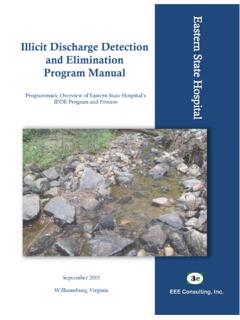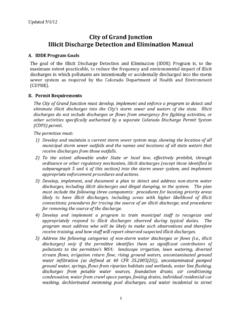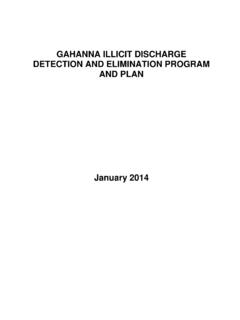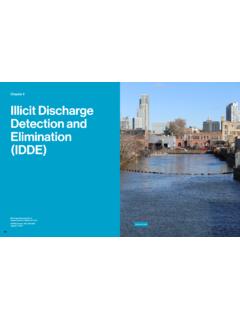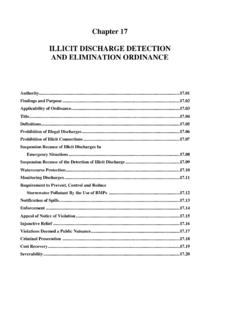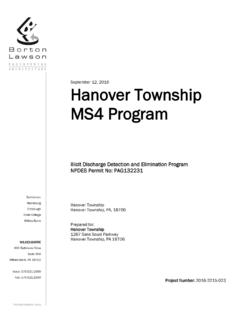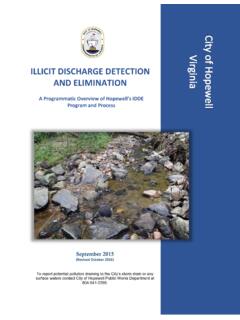Transcription of IDDE Field Guide - Eastern State Hospital
1 Eastern State Hospital illicit discharge detection and Elimination Field Guide For Elimination of Polluted Stormwater in Stormwater Systems Williamsburg, Virginia September 2015 IDDE Field Guide 1 ITEMS INCLUDED IN THIS Guide Introduction Examples of what IS an illicit discharge (Polluted Stormwater) illicit Connections Examples of what IS NOT an illicit discharge illicit discharge Initial Field Review Techniques for Conducting a Field Investigation Determining the Source of the illicit discharge Documentation of Suspected illicit Discharges Coordination of Actions Following Initial Field Review Closure for Suspect illicit Discharges IDDE Field Guide 2 INTRODUCTION Eastern State Hospital (ESH) is committed to ensuring that stormwater runoff from all its roadways and facilities comply with all federal and State environmental regulatory requirements.
2 Stormwater run-off is rainwater and melted snow that runs off the surface of streets, lawns, farms and construction and industrial sites. In undeveloped areas, much of the stormwater run-off is absorbed into the ground. That which is not absorbed by the ground ultimately flows into streams and rivers. Developed areas contain impermeable surfaces such as pavement and buildings that prevent stormwater from being absorbed into the ground, and thus increase stormwater runoff into storm drains, storm sewer systems and drainage ditches. Excess stormwater run-off has the potential for causing infrastructure damage, downstream flooding and stream bank erosion. Also, metals, oils and grease, bacteria and other pollutants not filtered from the runoff can contaminate streams, rivers, wetlands, etc. The Municipal Separate Storm Sewer System (MS4) Permit requires ESH to develop an illicit discharge detection and Elimination (IDDE) program.
3 The IDDE program must incorporate the following four elements: Develop an MS4 map showing the location of all outfalls; Develop and implement a plan to detect and address illicit discharges, including illegal dumping, to the ESH system; To the extent allowable under State law, prohibit illicit discharges into the MS4; and Inform public employees, businesses, and the general public of the hazards. This IDDE Field Guide is designed to assist Field personnel with detection , investigation and elimination of illicit discharges to ESH s regulated small MS4 and is designed to complement the ESH illicit discharge detection and Elimination Program Manual. This Guide describes conditions that personnel may encounter and actions they need to take, and it should be utilized in Field operations.
4 IDDE Field Guide 3 EXAMPLES OF WHAT IS AN illicit discharge What is an illicit discharge ? An illicit discharge is defined in the ESH MS4 permit as any discharge to a municipal separate storm sewer that is not composed entirely of stormwater, except discharges pursuant to a VPDES or VSMP permit (other than the VSMP permit for discharges from the municipal separate storm sewer), discharges resulting from firefighting activities, and discharges identified by and in compliance with 9 VAC25-870-400 D 2 c (3). Sanitary Stormwater from Showers, Sinks, etc. discharge of Oil, Fuel from Vehicles and Equipment Cooking Oil and Grease Solvents Grass Clippings and Leaves When Intentionally Blown into Drains IDDE Field Guide 4 Cleaning Chemicals Sediment Improper Disposal of Radiator Fluid Paints Non-residential Vehicle Wash Water Mismanagement/Excess Road Salt IDDE Field Guide 5 illicit Connections illicit connections occur when drainage pipes or other conveyances are improperly connected to the storm drain system.
5 These improper connections are often sources of illicit discharges. Examples include: A sewer pipe improperly connected to the storm sewer that is discharging raw sewage A shop floor drain that is connected to the storm sewer system A pipe from a residential household discharging gray water into storm drainage system Unpermitted Cross-Connections Unpermitted cross-connections are between the MS4 and sanitary sewer. Such connections increase the risk of introducing water polluted with human-related bacteria and other contaminants and are considered illicit discharges. Sewer can be attached to pipes and manholes that were either not identified or mistakenly identified. These connections must be removed and proper connections made to ensure the integrity of the MS4.
6 IDDE Field Guide 6 EXAMPLES OF WHAT IS NOT AN illicit discharge Foundation/Footing Drains Fire Fighting Activities Water Line Flushing Agricultural Irrigation Water Dechlorinated Swimming Pool Discharges Landscape Irrigation and Lawn Watering IDDE Field Guide 7 EXAMPLES OF WHAT IS NOT AN illicit discharge Basement/Crawlspace Sump Pumps Discharges from Potable Water Sources Air Conditioning Condensation Street Wash Water Springs Residential Car Wash Water IDDE Field Guide 8 EXAMPLES OF WHAT IS NOT AN illicit discharge Other discharges not considered illicit discharges include: Uncontaminated groundwater infiltration, Uncontaminated pumped groundwater, Rising groundwaters, Flows from riparian habitats and wetlands, and Those discharges covered under a Virginia Pollution discharge Elimination System (VPDES) or National Pollutant discharge Elimination System (NPDES) permit; Fuel, oil or antifreeze spills related to a vehicular accident that is properly cleaned up through normal incident management practices are not considered an illicit discharge .
7 Staff should nevertheless monitor the site during and/or after the incident to ensure that the cleanup is sufficient. Drums or other containers containing potentially hazardous materials that are found abandoned are considered unknowns or other potential hazardous materials cargo. Do NOT open containers. Contact your local hazardous material response team. Are there any exceptions? In the event that any of these activities are found to cause sewage, industrial wastes or other potentially significant sources of pollution to be discharged into the stormwater system, the source should be further investigated. The county or city having jurisdiction over the source shall be notified, as they have the authority to order the activity to cease. IDDE Field Guide 9 illicit discharge INITIAL Field REVIEW Polluted Stormwater (IDDE) work orders are typically generated from one of the following sources: 1.
8 Staff or Citizens observe a suspect discharge and report it The proper staff will follow guidance to determine if a call needs to be routed to local HAZMAT or if it is considered an illicit discharge (ID). The proper staff enters the information into the IDDE Tracking form. Proper procedures are followed to track and eliminate the discharge . Proper follow-up protocol are followed and documented to ensure that the ID was eliminated. 2. ESHmaintenance personnel observe an illicit discharge and report it to the Director of Operations. The proper staff will follow guidance to determine if suspected ID need to be routed to local HAZMAT or if it is considered an illicit discharge (ID). The proper staff enters the information into the IDDE Tracking form. Proper procedures are followed to track and eliminate the discharge .
9 Proper follow-up protocol are followed and documented to ensure that the ID was eliminated. Initial Field Review requires a site visit to determine if the condition described in the work order can be verified. The citizen or other reporting party should be contacted if the site location cannot be found, and in many cases, it may be advisable to meet them onsite. Many illicit discharges are intermittent and may not be present at the time of your visit, so the person may be capable of better isolating the time and circumstances surrounding the discharge they reported. The proper staff will conduct initial Field reviews for potential illicit discharges. These assignments will be coded as Polluted Stormwater (IDDE). IDDE Field Guide 10 TECHNIQUES FOR CONDUCTING A Field INVESTIGATION During Field investigations, suspect discharges should be evaluated based on: Odor Odors may indicate an illicit discharge has occurred.
10 The presence of sewage, sulfide, or rancid/sour odors may indicate the presence of wastewater in the system. Petroleum and chemical odors may indicate that a possible spill has occurred nearby. Color Certain water colors may also indicate the presence of an illicit discharge . Brown, gray, yellow, green, orange or red water should be noted. Water that is tinted brown may be due to the presence of naturally occurring tannins in the surrounding environment and may not be an illicit discharge . Turbid, cloudy water may indicate the presence of excessive siltation or other pollutants entering the stormwater. Staining/Discoloration The presence of stains or discoloration in or around an outfall may be signs that an illicit discharge is occurring or has occurred. Stains or discoloration often originate from natural sources, including water with high concentrations of iron or other minerals, lichen/fungi, and mineral deposits on stone or concrete.
